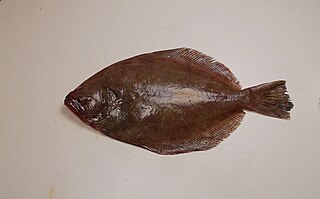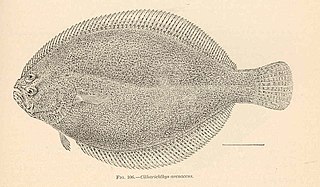
The California halibut or California flounder is a large-tooth flounder native to the waters of the Pacific Coast of North America from the Quillayute River in Washington to Magdalena Bay in Baja California. It feeds near shore and is free swimming. It typically weighs 6 to 30 pounds. It is much smaller than the larger and more northern-ranging Pacific halibut that can reach 300 pounds (140 kg).

Cyclopsetta fimbriata, the spotfin flounder, is a species of large-tooth flounder native to the western Atlantic Ocean. It ranges along the Eastern coast of North America, from North Carolina in the north to the coast of Brazil in the south. It is abundant around the coast of Florida and in the Gulf of Mexico. It can be found among reefs and has a depth range of 20–230 metres.

Paralichthys adspersus, the fine flounder, is a species of large-tooth flounder native to the eastern Pacific Ocean, along the continental shelf from the coast of Ecuador in the north to the coast of Peru in the south.

The summer flounder or fluke is a marine flatfish that is found in the Atlantic Ocean off the East Coast of the United States and Canada. It is especially abundant in waters from North Carolina to Massachusetts.

Paralichthys lethostigma, the southern flounder, is a species of large-tooth flounder native to the East Coast of the United States and the northern Gulf of Mexico. It is a popular sport fish and is the largest and most commercially valuable flounder in the western North Atlantic Ocean and Gulf of Mexico. It is a "left-eyed flounder", meaning the left side is pigmented and is the "up side".

Hippoglossina oblonga, is a flatfish and member of the large-tooth flounder family Paralichthyidae. This species has been placed in the genus Paralichthys by some authorities.
Citharichthys gordae, the mimic sanddab, is a species of sanddab in the large-tooth flounder family Paralichthyidae. It is native to the eastern Pacific Ocean, found off the coast of Mexico. It has a limited distribution, found in the Magdalena Bay and along the Baja California peninsula, as well as part of the Gulf of California.

Ancylopsetta dilecta, the three-eye flounder, is a species of large-tooth flounder found along the Atlantic and Caribbean coasts of North and Central America. It is found down to depths of 137 m (449 ft). This species grows to 25 cm (9.8 in) in total length.

Ancylopsetta ommata, the Gulf of Mexico ocellated flounder, is a species of large-tooth flounder native to the Atlantic coast of North America and the Gulf of Mexico. It is found at depths from 4 to 110 m. This species grows to 25 cm (9.8 in) in total length.
Citharichthys platophrys, the small sanddab, is a species of sanddab in the large-tooth flounder family Paralichthyidae. It is native to the eastern Pacific Ocean, ranging from the southern Gulf of California of Mexico in the north to Peru in the south.
Citharichthys fragilis, the Gulf sanddab, is a species of sanddab in the large-tooth flounder family Paralichthyidae. It is native to the eastern Pacific Ocean, ranging from the coast of Manhattan Beach, California in the north to the Gulf of California in the south.

Etropus rimosus, the gray flounder, is a species of flounder in the large-tooth flounder family Paralichthyidae. It is native to the western Atlantic Ocean, ranging from the coast of North Carolina to the south of Florida. It can also be found in the eastern Gulf of Mexico.
Citharichthys gymnorhinus, the anglefin whiff, is a species of flatfish in the large-tooth flounder family Paralichthyidae. It is a demersal marine fish that inhabits the mid to outer continental shelf of the western Atlantic Ocean, in both tropical and subtropical waters. It ranges from the Bahamas and Florida in the north to Guyana and Nicaragua in the south, though larvae samples have also been collected off the coast of Canada. It occurs at depths between 35 and 200 metres, but is most commonly found in shallower waters.
Citharichthys gilberti, the bigmouth sanddab, is a species of flatfish in the large-tooth flounder family Paralichthyidae. It is native to the eastern Pacific Ocean, in tropical waters ranging from the Gulf of California in the north to Peru in the south. It occurs in shallow waters off the coast, to a maximum depth of 36 m (118 ft).
Citharichthys mariajorisae, the five-rayed sanddab, is a species of flatfish in the large-tooth flounder family Paralichthyidae. It is native to the eastern Pacific Ocean, in tropical waters ranging from the Gulf of California in the north to the Bay of Panama in the south. It is a demersal marine fish, inhabiting the sandy bottoms of shallow coastal waters at a depth between 10 and 45 metres.
Citharichthys abbotti, the Veracruz whiff, is a species of flatfish in the large-tooth flounder family Paralichthyidae. It is endemic to the southwestern Gulf of Mexico, found on the Eastern Mexico Continental Shelf, with Veracruz to the south and the Rio Grande to the north.
Citharichthys amblybregmatus is a species of flatfish in the large-tooth flounder family Paralichthyidae. It is native to the western north Atlantic Ocean. It has been collected at a depth of 198 m (650 ft).

Citharichthys cornutus, the horned whiff, is a species of flatfish in the large-tooth flounder family Paralichthyidae. This bathydemersal marine fish inhabits the continental shelves of the western Atlantic Ocean, in both tropical and subtropical waters. It ranges from New Jersey in the north to Uruguay in the south, though larvae samples have also been collected off the coast of Canada. It occurs at depths between 30 and 400 metres, though it is usually found in deeper waters.

Citharichthys arenaceus, the sand whiff, is a species of flatfish in the large-tooth flounder family Paralichthyidae. This demersal marine fish inhabits the western Atlantic Ocean, occurring in shallow tropical coastal waters, as well as in estuaries, bays, and lagoons. It ranges from Florida, United States, in the north to the West Indies and Brazil in the south.
The limbless snake-tooth skink is a species of skink found in Queensland in Australia.











